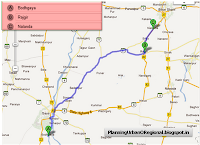Expanding tourism infrastructure in India


HIMACHAL PRADESH:
HARYANA & HIMACHAL PRADESH:
The Ministry of Tourism of India has identified 45 Mega Tourist Destinations/ Circuits in consultation with the concerned State Governments/ Union Territories (U.T.) Administrations on the basis of footfalls and their future tourism potential. Out of the 45 identified projects, 30 have already been sanctioned. Some of the Tourist circuits along with indicative maps are given below.
ASSAM:
National Park Mega Circuit covering Manas,Orang, Nameri,Kaziranga, Jorhat,Sibsagar & Majouli
BIHAR:
Bodhgaya-Rajgir-Nalanda- Circuit
CHATTISGARH:
Jagdalpur-Tirathgarh-Chitrakoot-Barsur-Dantewada-Tirathgarh Circuit
GUJARAT:
1) Dwarka-Nageshwar-BetDwarka Circuit
2) Shuklatirth-Kabirvad-Mangleshwar-AngareshwarCircuit
HARYANA:
Panipat-Kurukshetra-Pinjore Circuit
HIMACHAL PRADESH:
Eco and Adventure Circuit (Kullu-Katrain-Manali)
HARYANA & HIMACHAL PRADESH:
Panchkula –Yamunanagar(Haryana) – PontaSahib
JAMMU & KASHMIR:
Naagar Nagar Circuit (Watlab viaHazratbal,Tulmullah, Mansbaland Wullar Lake), Srinagar
Bundelkhand comprising of Tikamgarh, Damoh, Sagar, Chhatarpurand Panna
MAHARASHTRA:
Mahaur-Nanded -Vishnupuri Back Water- Kandhar Fort
ORISSA:
Bhubaneshwar-Puri-Chilka- Circuit
RAJASTHAN:
1) Ajmer- Pushkar
2) Jodhpur-Bikaner-Jaisalmer
TAMILNADU:
Pilgrimage Heritage Circuit (Madurai-Rameshwaram-Kanyakumari)
UTTARAKHAND:
Haridwar-Rishikesh-Munikireti- Circuit
UTTAR-PRADESH:
1) Varanasi-Sarnath-Ramnagar Circuit
2) Mathura-Vrindavan
Data Source: http://pib.nic.in/,
Images prepared with help of Google Map



















